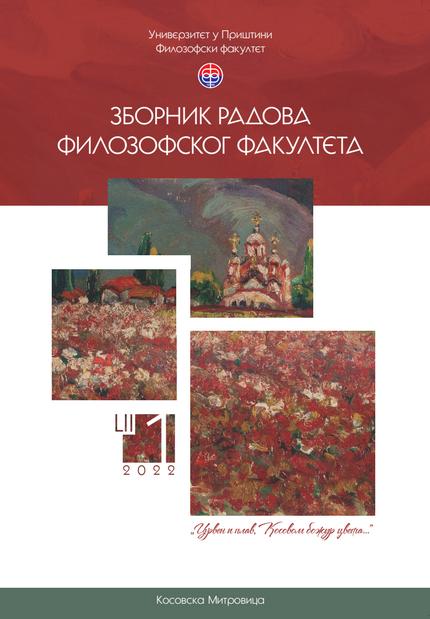The Fandas in the Prizren and the Peć Sanjaks 1905–1908
Abstract
Albanian Roman Catholics, fandas, were settled in the Prizren and the Peć Sanjaks and in the area around Đakovica. Over time, their number increased with newcomers from the north of today’s Albania and with high birth rates. In the areas where they were inhabited, they acted in an organized manner and, together with the Muslim Albanians, attacked the Serb population. They committed daily atrocities against the Serbs, who were forced to abandon or undersell their properties; they sought salvation outside the borders of the Ottoman Empire. The actions of the fandas, organized into groups, were well designed and supported by the Roman Catholic priests and the Austro-Hungarian representatives, which also aimed to displace the Serb population from Metohija. Numerous examples were noted that point to the coordinated action of Austrian diplomats and Roman Catholic priests in the Kosovo vilayet. Their help and support additionally encouraged the fandas to continue with even more frequent and stronger attacks on the Serbs in the Peć and the Prizren Sanjaks.
Ottoman authorities were often powerless to oppose and prevent Albanian Mohammedans and fandas from committing atrocities. The Serbs turned to the consul of the Kingdom of Serbia in Priština and the Russian consuls in Prizren and Mitrovica for help. Realizing that the fandas were persistent in their intention to displace the Serbian population, Consul Miroslav Spalajković proposed certain measures to the Government in Belgrade that could affect the improvement of the situation. His opinion was supported by the later consul, Milan Rakić. The consul’s concern for the survival of the Serb population was justified and the reports to the Belgrade Foreign Ministry were replete with grim events describing numerous arson, killings, thefts, and large numbers of victims.
The situation in the Kosovo vilayet had been further exacerbated by the resistance from the Albanians who opposed the reforms. The resistance and demand of Albanian Mohammedans were joined by Albanian Roman Catholics. However, some time later, after the incident in the mosque in the village Smonice in the Đakovica area, there was a conflict between the two sides, which spread to other parts. Until this conflict, the Albanian Mohammedans and fandas in Đakovica lived in relatively good relations. There were blood feuds among them, but they were resolved like all the others among the Albanians themselves. Among the conflicting parties, a new and important element appeared, the religious element. As an epilogue to the conflict and the fight between the two warring parties, there were many wounded and dead. Regardless of that, the oppression towards the Serbs had not decreased, so the Serbian consul in Priština came up with the idea to use the situation and request additional army forces be sent.
The Mohammedan leaders resorted to the tried and tested method of tying besa, first in Peć, where they held a meeting and formed a committee for protection against evil deeds, which included four Serbs. After that, gatherings were held in other parts of the Kosovo vilayet, where, among other things, the issue of fandas was discussed. The Consulate General of the Kingdom of Serbia in Skoplje had information on the complete reconciliation of Mohammedans and Roman Catholics and the conclusion of a political agreement. A new situation in the Ottoman Empire soon followed—on July 24, 1908, the Constitution was proclaimed and the Young Turks took power. However, the Serbs of the Peć and the Prizren Sanjaks did not benefit from that, because crimes, murders, arsons, and the reactivation of the Roman Catholic Committee continued.
References
Аншаков, Ю. П. (2014). Российская дипломатия о положении славянского населения Старой Сербии (1902–1912 гг.). Известия Самарского научного центра Российской академии наук, т. 16. № 3. Самара: Самарский научный центр Российской академии наук, 170–189.
Богдановић, Д. (1985). Књига о Косову. Београд: Српска академија наука и уметности.
Заркович, В. (2019). Римско–католическая пропаганда на службе Австро–Венгрии в Старой Сербии в конце XIX и начале XX вв. Религия. Церковь. Общество, VIII. Санкт–Петербург: Теологический институт Евангелическо–лютеранской Церкви Ингрии, Межрегиональный центр духовно-нравственного просвещения и межрелигиозного сотрудничества, Кафедра социологии и религиоведения РГПУ им. А. И. Герцена, 270–290.
Косово и Метохија у српској историји. (1989). Београд: Српска књижевна задруга.
Микић, Ђ. (1977). Настојање Србије на отварању руског или енглеског конзулата у Пећи 1908. године. Обележја, 1, 149–167.
Микић, Ђ. (1985). Друштвене и економске прилике косовских Срба у XIX и почетком XX века (од чифчијства до банкарства). Београд: Српска академија наука и уметности.
Толева, Т. (2018). Утицај Аустроугарске империје на стварање албанске нације, 1896–1908. Београд: Институт за европске студије.
Ћоровић, В. (1992). Односи између Србије и Аустро–Угарске у XX веку. Београд: Библиотека града Београда.
Zarković, V. (2020). Fandas and Оperation of the Austria–Hungary in Prizren and Peć Sanjak (1900–1905). Баштина, 50, 271–289.
The details about the publication policy, including copyright and licensing, are available at:

